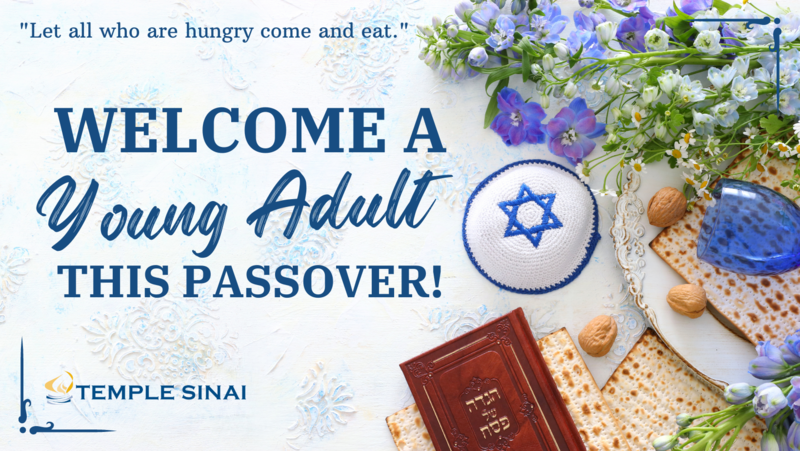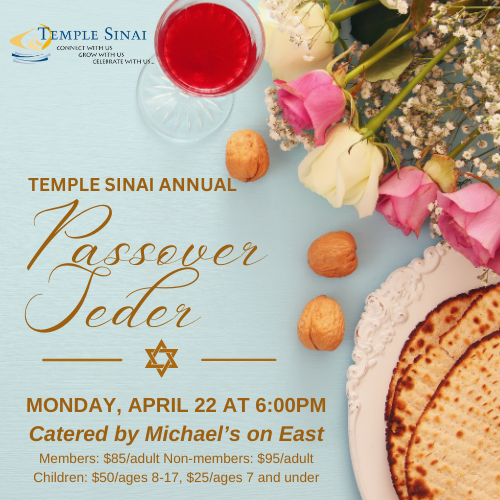Welcome a Young adult to your seder

|
Let all who are hungry come and eat. The Sarasota Young Jewish Adult (YJA) group has grown to over 180 members in the past couple of years. Some of these folks do not have a place to go for Passover; please remind them why Temple Sinai has the reputation for being the most welcoming temple in the community! If you are willing to 1) sponsor one or more YJA member to join you at the Temple Sinai Congregational Seder, OR, 2) invite them to your personal Seder, please email us at Office@templesinai- |
Passover
“In each and every generation a person is obliged to regard him/herself as if he/she had come out of Egypt.” Haggadah
Each year the holiday of Passover returns during the springtime, recounting the story of the Israelites liberated from Egyptian slavery. Jews tell this story, with the assistance of a Haggadah, to remind us that in every generation, throughout time, all Jews regardless of status, age or gender are to feel as if we personally made this journey as our ancestors had. We are obligated to retell this story because our freedom is not to be taken for granted, it is a sacred redemption. The Exodus is a powerful spiritual liberation, not just a physical one. The quote above talks about how each and every generation has this responsibility. The generations are not only time-bound, for every human within them carries this obligation. This narrative celebrates resilience, renewal and freedom.
Passover falls on the eve of the 15th of the Hebrew month of Nisan, lasting for seven or eight days depending on if you are an Israeli or a Reform Jew or if you are an Orthodox or Conservative Jew living in the Diaspora. It is one of only a few holidays celebrated privately in homes, centered around a meal, making it one of the most celebrated holidays by Jews next to Chanukah and the High Holy Days.
The traditional meal, called a Seder (meaning “order”), is outlined in a book called the Haggadah which is read aloud at the dinner table. Haggadah means “the telling” of the story - the exodus from Egypt. The Haggadah also lists the order the story is told as well as the ritual foods which are blessed first, and then eaten.
There are six symbolic foods on the Passover Seder plate: Maror (the bitter herbs), charoset (chopped apples, nuts, cinnamon and sweet red wine), karpas (parsley), chazeret (lettuce), zeroah (shankbone), and beitzah (egg). The all have a unique symbolism to remind us of the bitterness of slavery in Egypt, the Passover sacrifice of a lamb in ancient Jerusalem, and the renewal of life in the spring.
The most commonly recognized food for Passover is the unleavened bread, or matzah, which reminds us of how our ancestors fled quickly from Egypt when freed not having enough time to fully allow their bread to rise. “They baked the dough that they took out of Egypt into unleavened cakes [matzot], for it was not leavened, since they were driven out of Egypt and could not delay; nor had they prepared provisions for themselves” (Exodus 12:39). It became known as the bread of affliction as there were few ingredients given to the Hebrews at the time, but it also became the symbol of freedom. At the seder, the middle matzah is broken in half by the leader, and then hidden for children to find after the main meal. It must be returned to the leader, for a small reward, for the seder to finish with this as the dessert.
We wish all who are celebrating this holiday to have a meaningful seder experience with family and friends while fulfilling our sacred obligation to retell the story as we appreciate the freedoms we have today. Chag Pesach kasher vesame’ach - Have a happy and blessed Passover!







